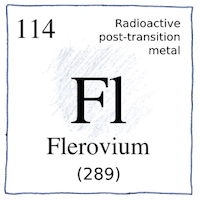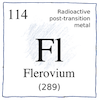Flerovium
Scientists at Dubna, having bombarded plutonium-244 with calcium-48, announced that they had synthesized one atom of isotope of element 114 with 175 neutrons, but subsequent work was not able to reproduce the same results. So later in 1999 they bombarded plutonium-242 and thought that they had synthesized two atoms of isotope of element 114 with 174 neutrons, but by 2002 they realized that was wrong, too. They kept working on the problem through 2007 and were able to show that they had synthesized isotopes of element 114 with 172 and 173 neutrons, which scientists at Berkeley were able to confirm.
Atomic number 114
If only we could synthesize flerovium with 184 or 196 neutrons, we might find these isotopes would be especially stable. However, none of the 90 or so flerovium atoms found so far had more than 145 neutrons, and the longest half life of these has been five and half seconds.
Unconfirmed stuff
Nuclei of elements like flerovium are thought to be squashed spheroids with protons and neutrons arranged into shells. Eventually, theorists propose, the magic numbers of protons and neutrons should complete a shell and remain close enough for the strong nuclear force to keep them together. The strong nuclear force. The strong nuclear force binds the parts together into a whole that lasts, into a whole that lasts.




The Russians might have created an atom of the metastable isomer 289mFl in 1999, but that one atom was gone in a moment; blink and you’d have missed it. It was gone in a moment and has never come back since.
In the first successful experiments, the team created two atoms of flerovium-288, and one atom of flerovium-289.
See also in The book of science:
Readings in wikipedia:
Other readings: